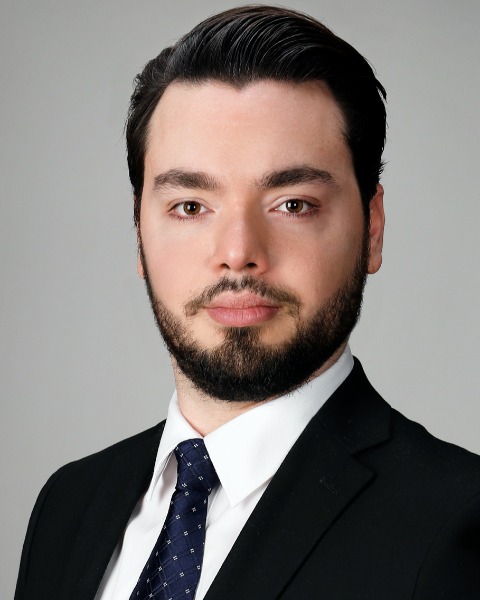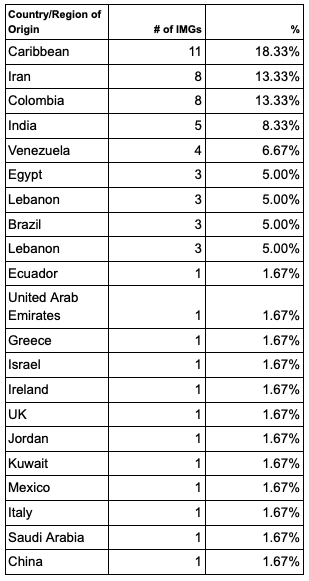Back
Poster, Podium & Video Sessions
Podium
PD30: Education Research III
PD30-05: International Medical Graduates in Urology: Tracking Success through Research Experience
Saturday, May 14, 2022
1:40 PM – 1:50 PM
Location: Room 243
David E. Hinojosa-Gonzalez*, Anton Wintner, Dimitar V. Zlatev, Boston, MA, Wesley A. Mayer, Houston, TX, Ruslan Korets, Brian H. Eisner, Boston, MA

David Eugenio Hinojosa Gonzalez, MD
Massachusetts General Hospital
Podium Presenter(s)
Introduction: International Medical Graduates (IMGs) constitute nearly 25% of the current physician workforce in the United States. However, IMGs account for only ~ 2.2% of all urology matched residency positions per cycle. This study aims to identify the countries of origin, research pathways and residency destinations of successfully matched IMGs in urology.
Methods: The rosters of 145 urology residency programs were screened for IMG residents. PubMed searches were conducted for each identified IMG and the affiliations of research predating their start of residency were recorded. Total research activity as well as geographical mapping based on research affiliations were compared to IMG resident matching sites
Results: Fifty-seven matched IMGs were identified from 2016-2021 Urology Residency Match Program cycles, making up 3.2% of the identified resident pool. . The most common international medical schools represented by matched IMGs were as follows: 11 from the Caribbean (18%), 8 from Iran (13%), 8 from Columbia (13%) and 5 from India (8%).(Table 1). Thirty-nine (68%) IMGs had dedicated research years in the US before applying. Of these, 37/39 (94%) participated in urology-specific research. Mayo Clinic, Johns Hopkins, Massachusetts General Hospital, Mount Sinai and MD Anderson were the most common sites for research years. Florida residency programs have the most IMGs, with a total of 10 (17.5% of total IMGs) IMGs, followed by Texas with 6 (10.5%) and California, Massachusetts, and New York each with 4 (7%). Forty out of 145 total programs have at least one IMG resident (27.5%)
Conclusions: IMGs represent a minority of the current urology resident workforce. Most devote one to two years to research at prestigious institutions before matching. Florida and Texas are the most frequent destinations for IMGs.
Source of Funding: No funding was received

Methods: The rosters of 145 urology residency programs were screened for IMG residents. PubMed searches were conducted for each identified IMG and the affiliations of research predating their start of residency were recorded. Total research activity as well as geographical mapping based on research affiliations were compared to IMG resident matching sites
Results: Fifty-seven matched IMGs were identified from 2016-2021 Urology Residency Match Program cycles, making up 3.2% of the identified resident pool. . The most common international medical schools represented by matched IMGs were as follows: 11 from the Caribbean (18%), 8 from Iran (13%), 8 from Columbia (13%) and 5 from India (8%).(Table 1). Thirty-nine (68%) IMGs had dedicated research years in the US before applying. Of these, 37/39 (94%) participated in urology-specific research. Mayo Clinic, Johns Hopkins, Massachusetts General Hospital, Mount Sinai and MD Anderson were the most common sites for research years. Florida residency programs have the most IMGs, with a total of 10 (17.5% of total IMGs) IMGs, followed by Texas with 6 (10.5%) and California, Massachusetts, and New York each with 4 (7%). Forty out of 145 total programs have at least one IMG resident (27.5%)
Conclusions: IMGs represent a minority of the current urology resident workforce. Most devote one to two years to research at prestigious institutions before matching. Florida and Texas are the most frequent destinations for IMGs.
Source of Funding: No funding was received


.jpg)
.jpg)